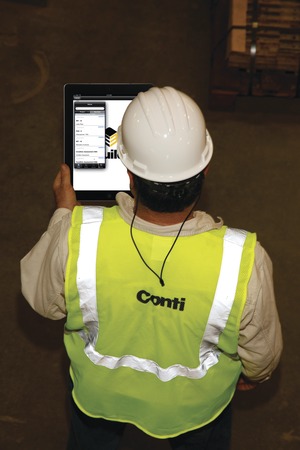

To define the extent of Superstorm Sandy's damage to residential properties, New York City and the Federal Emergency Management Administration last fall issued a request for proposals for a rapid repair program. One of the winning contractors now credits its use of a mobile construction program management app and a fleet of iPad minis for its ability to meet the city's exacting requirements.
Joe Berkowitz, project manager for Conti Construction Corp., Edison, N.J., says his crews started with conventional methods and quickly realized they were getting bogged down. "We were working seven days a week" just to collect the data, he says. "What differentiated this event from Hurricane Katrina is there wasn't as much open real estate to house victims," he adds. "You couldn't throw trailers up everywhere for displaced people."
There was pressure to help storm victims as quickly as possible. Berkowitz says the first house he visited on Staten Island was the home of an elderly couple that was almost covered in water. They had no flood insurance. "I've been doing this 20-odd years, and this was the first time I was moved emotionally—and not in an angry way," says Berkowitz.
The contract called for the team to check the status of heat, electricity and hot-water services as part of FEMA's Sheltering and Temporary Essential Power program. After a few days and hundreds of properties, Berkowitz realized they could capture and manage the data using mobile tools and e-Builder Enterprise, a cloud-based system for construction program management that Conti has used since 2009. "We [knew we] could save a lot of data-entry time," says Berkowitz.
The vendor responded with quick support and helped Conti create a tool that mimicked the city's work-order form. Meanwhile, the team realized they needed field devices, says Berkowitz. With the blessing of the company's CIO, they turned to iPad minis, which are less expensive than full size iPads and have a better form factor for fieldwork, he says. The next day, Conti had six devices in the field, inputting data.
The process called for the contractor to send a team of engineers and tradesmen, accompanied by a city representative, to each home to do an assessment and fill out a work order. After the Conti team performed and signed off on each assessment, a city monitor followed suit, authorizing repairs.
Conti's form has 116 fields, but only 20 require typed entries; the rest of the data is easily updated with the touch of a finger on pull-down menus. One field is a notes section that accepts typing or can use the voice-dictation feature of the iPad. Photos can be attached without leaving the data-collection app.
"The city was extremely data-driven and expected a lot from us, daily, in terms of reporting," Berkowitz says. Conti transmitted reports to Mayor Michael Bloomberg's office every day.
The most recently updated version of e-Builder Enterprise delivers enhancements to the entire system, but some of the most substantial are for its mobile app, says Jonathan Antevy, co-founder of Plantation, Fla.-based e-Builder. "Workflow is the same in the field as in the office," Antevy says. One new mobile feature includes the ability to resize photos before uploading, saving space and time.
"By the end of the project, we had 38 iPads minis out in the field," says Berkowitz. He says it was easier to get workers to use the devices than any mobile technology he has ever implemented.
"Our VP of construction kept his, and the general [superintendent] won't give his back," adds Berkowitz.




Post a comment to this article
Report Abusive Comment